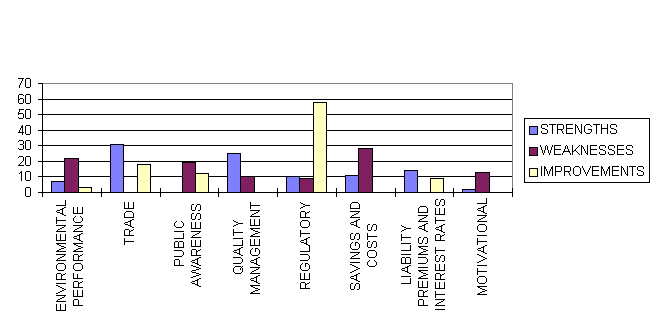Benchmarking Perceptions of ISO 14001
Published in Moving ahead with ISO 14001
Eds. Philip A Marcus and John T Willig. 1997, John Wiley and Sons, Inc. pp 85-94
By David Burdick P.E.
In November of 1995, Global Environmental Management System conducted an open ended survey with top environmental executives of 11 of the leading US corporations, including IBM, Hewlett Packard, Proctor and Gamble, 3M, Johnson and Johnson, Motorola, General Electric, Herman Miller, 4 of the largest international consultant firms including ABB Environmental Services and Woodward-Clyde and the 3 top registrars BVQI, Lloyds and SGS International Certification. The purpose of which was to benchmark the present perceptions of the ISO 14001 amongst key US manufacturing, consultants and registrars. The following open-ended questions were asked.
- What do you perceive are the strengths and weaknesses of implementing the ISO 14001 EMS within your or your client’s organization?
- What do you perceive could be done to improve the acceptance of the ISO 14001 EMS by industry?
- Do you plan on implementing the ISO 14001 and when?
Below is a synopsis of their responses. The answers fell into 9 categories:
- ENVIRONMENTAL PERFORMANCE
- TRADE
- PUBLIC AWARENESS
- QUALITY MANAGEMENT
- REGULATORY
- SAVINGS AND COSTS
- LIABILITIES, PREMIUMS AND INTEREST RATES
- MOTIVATION
- CERTIFICATION
STUDY RESULTS

Figure 1 Comparison of the average perception amongst mfg., consulting firms and registrars as to the strengths, weaknesses and suggested improvements to the acceptance of ISO 14001 EMS
ENVIRONMENTAL PERFORMANCE
Although the intent of the ISO 14001 draft standard does not itself state specific environmental performance criteria beyond commitment to [an organization’s] policy, it requires procedures to be establish to monitor and measure the key characteristics of its operations that can have a significant impact on the environment.
Only 7% of comments perceived this area to be a strength of the ISO 14001. 22% of comments perceived this area to be a weakness of the ISO 14001, as there is “No guarantee of an actual and continuous improvement in reducing environmental impact.” Yet only 3% of comments perceived a need to emphasize continuous improvement in the standard as a means to improve the acceptance of ISO 14001.
TRADE
One of the main intents of the ISO 14001 draft standard is to prevent the creation of non-tariff trade barriers and to increase or change an organization’s legal obligations. Yet there is language to encourage contractors and suppliers to establish an EMS.
A large percentage, 31% of comments perceived the competitive advantage of being able to market to customers who require ISO 14001 and for leadership recognition as strengths of the ISO 14001. No one perceived trade issues to be a weakness of the ISO 14001. 18% of comments perceived trade issues as a means to improve the acceptance of ISO 14001, with comments such as “Need for clear marketing trends” and “Need for environmental groups and customer-supplier relationships to embrace and push for EMS and Eco-labeling in products”
PUBLIC AWARENESS
The ISO 14001 draft standard requires that the company’s environmental policy be available to the public, as well as to communicate relevant matters to external interested parties.
None of comments perceived public awareness to be a strength of the ISO 14001. In fact, 19% of comments perceived this area to be a weakness of the ISO 14001, with comments such as “lack of public knowledge”, and “lack of experience to get measurable results”. 12% of comments perceived improved public awareness as a means to improve the acceptance of ISO 14001; sighting comments such as ”Need for customer, public’s and organization’s awareness” and “Need shifts in attitudes”
QUALITY MANAGEMENT
One of the intents of the ISO 14001 draft standard is to offer an effective and structured management system which, when implemented, maintain and improve environmental policy and objectives. It shares the common management system principles with the ISO 9000 quality system standards, with the additional point that it must “address the needs of a broad range of interested parties and the evolving needs of society for environmental protection.”
A good quarter of comments perceived this area to be a strength of the ISO 14001, with such comments as “Harmonize throughout a large multinational corporation”, “Systematically manage & improve ones environmental management system”, “gives one universally accepted standard”, “is consistent environmental framework”, “Gain operational efficiency”, “Benchmark improvements”, and “develop Pro-active management”. 10% of comments perceived this area to be a weakness of the ISO 14001, with comments such as “potentially becomes a paperwork exercise”. None of the comments had perceived this area in need of improvement in order to increase the acceptance of ISO 14001.
REGULATORY COMPLIANCE
An objective of the ISO 14001 draft standard is to establish a system that requires that regulations be heeded.
Only 10% of comments perceived this area to be a strength of the ISO 14001, with perceptions such as “Reduction in regulatory inspection”, reduced ”compliance exposure and costs” and “Improvements from systematic compliance”. 9% of comments perceived this area to be a weakness of the ISO 14001, sighting “Potential for loss of confidentiality” and “Meeting voluntary standards will then become de facto regulations”. However, a substantial 58% of comments perceived this area in need of improvement in order to increase the acceptance of ISO 14001. Suggested improvements include: “Need the US EPA to make more tangible incentives to industry”, “Reduction of inspection, monitoring and reporting”, “Reduction of time required for attaining permits”, “Decrease in fines”, ”Protection of audit results” and “Federal requirements for ISO 14001 registration for government projects”
SAVINGS & COSTS
The intent of the ISO 14001 draft standard does not specifically set out to reduce cost or improve material or energy savings, but it could be a significant byproduct of implementing the ISO 14001 Environmental Management System. The review and policy statement suggests addressing these impacts for organizations that have significant use of energy and material use.
11% of comments perceived this area as a strength of the ISO 14001, with perceptions such as “Reduction of material and energy usage”, and “Improved efficiency”. A rather substantial 28% of comments perceived this area to be a weakness of the ISO 14001; with perceptions reflected in the comment ”Manpower costs will not be worth the savings”. None of the comments perceived this area to be in need of improvement in order to increase the acceptance of ISO 14001
LIABILITY PREMIUMS AND INTEREST RATES
The intent of the ISO 14001 draft standard does not specifically set an objective to reduce liability premiums of insurance interest rates.
14% of comments perceived this area to be a strength of the ISO 14001, with perceptions such as “Reduction of liability”, and “Reduction in insurance premiums”. None of the comments perceived this area to be a weakness of the ISO 14001. 9% of comments perceived this area in need of improvement in order to increase the acceptance of ISO 14001, with the suggestion of “A need for premium and liability reduction to drive acceptance”.
MOTIVATION
The standard does not specifically set an objective to motivate acceptance. However, top management must define and commit to the environmental policy and be involved in its review and improvement. It is also a requirement of the standard to promote environmental awareness of the company’s activities and its reduction its impact.
Only 2% of comments perceived this area to be a strength of the ISO 14001, with perceptions such as “Improvement in company pride” and “Motivation”. 13% of comments perceived this area to be a weakness of the ISO 14001, with comments such as “Concern that there are no short term benefits perceived to motivate industry”. None of the comments perceived improved motivation in order to increase the acceptance of ISO 14001.
CERTIFICATION
The August draft of the ISO/DIS 14001 standard allows for self-certification by organizations.
85% of the companies that are making gap analysis to the standard but are not willing to publicly state when, if ever, they will gain registration. Registrars, on the other hand, are finding a large increase in request for certification.
CONCLUSION
The top three perceived strengths of implementing the ISO 14001 EMS within an organization were: Trade (31%), Quality Management (25%) And Liability Premiums and Interest Rate Reduction (14%).
The top three perceived weaknesses of the ISO 14001 EMS within an organization were: Costs (28 %), Lack of Environmental Performance (22 %) and Lack of Public Awareness (19 %).

Figure 3 Perceived weaknesses in ISO 14001 EMS
The top three areas for areas to improve the acceptance of the ISO 14001 EMS by industry were: Regulatory Incentives (58 %), Trade (18%) and Public Awareness (12%).
The goals of the ISO Strategy Advisory Group (SAG) is to develop a standard which promotes a common approach to EMS (Quality Management), enhance an organization’s ability to attain and measure improvements in environmental performance (Environmental Performance) and facilitate trade and eliminate non-tariff trade barriers (Trade)
Manufacturing, consulting firms and registrars likewise perceived the strengths encapsulated in Quality Management: i.e., harmonizing of one EMS standard and Trade i.e. eliminate non-tariff barriers between nations, as strengths of the ISO 14001 standard.
However, contrary to the third objective of the ISO 14001 standard, Environmental Performance was not perceived as a strength of the ISO 14001. In addition, Regulatory incentives, in the form of regulatory relief and government requirement in were suggested as means to improve the acceptance of ISO 14001.
There was a strong difference concerning certification between the perceptions of industry verses the registrar. Although 85% of manufacturing was non-committal and uncertain when if ever they will get third party certification, the finding from registrars is that there is a large increase in companies requesting registration. This may be due to the competitive nature involved in keeping secret plans to becoming the first within an industrial sector to be registered to the ISO 14001 standard. As one registrar said, when the window of opportunity becomes clear, it’s too late, and one can only follow.
Bibliography:
David Burdick’s 15-year experience reflects a blend of international acumen, academic knowledge and manufacturing expertise. He has been involved in certification practices for several years, including establishing an office in Japan, auditing Quality and Environmental management systems in the US and developing LCA criteria for determining more sustainable and environmentally preferable products.
He is currently principal at Sustainable Steps, (www.sustainablesteps.com), an organization committed to verifying steps towards sustainable business practices and includes authentication to several certification schemes. Among them are accreditation requirements ISO 62 and ISO 66, organizational requirements ISO 9000 (Quality) and ISO 14001 (Environmental) Management Systems; eco-labeling programs, the National Organic Program and Forest Stewardship Council (FSC) Chain-of-Custody for sustainably harvested timber.
He has degrees in Mechanical and Industrial engineering, a Masters in Environmental Decision Making, a Professional Engineering license and has lived and worked 8 years abroad; 5 in Denmark and 3 years in Japan.
David Burdick PE
Sustainable Steps
USA
Tel: (+1) 503 654-2070
Email: ![]()
Website: https://sustainablesteps.com

